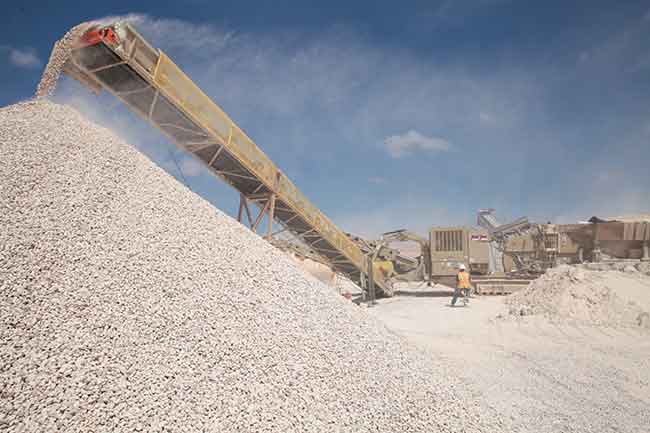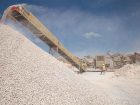
Features
Aggregates
Technology
Conveyor guarding
Increasing safety measures for conveying equipment
September 13, 2017 By Wade Lippert
 Even the most basic stacking conveyors require safety measures to be in place.
Even the most basic stacking conveyors require safety measures to be in place. September 13, 2017 – The level of danger with conveying equipment can be deceiving because the conveyor doesn’t make a lot of noise and is only moving material from one end to another. However, statistics show that conveying equipment is responsible for more injuries than most all other quarry equipment combined. This is exactly why conveyor guarding is so important.
When reviewing the safety of equipment, first evaluate the individual risks. Risk assessment begins at the OEM manufacturer in an evaluation of the machine’s guarding against the manufacturer’s standard guarding practices, but it shouldn’t end there. Other variables, such as conveyor placement, on-site modifications, and physical access (walkways, accessible reach to moving components, etc.) cannot be predicted by the OEM. As a result, it is essential for the owner to evaluate and identify the individual dangers.
The most basic stacking conveyors need safety measures in place. At a minimum, every conveyor includes at least two rotating shafts at the head and tail pulleys. Rotating shafts present the first point of interest for guarding. The shaft rotation could snag and wrap up loose clothing, which could result in pulling an individual into the conveyor, causing severe injuries. Often, the OEM will provide a guard for the tail pulley to prevent injury.
The second most common component requiring guarding is the return idler. The return idler guard is in place to prevent exposing a nip point. Depending on the design of the guard, material can build up causing the roller to stop, which can lead to belt mistracking causing damage to the conveyor. To remove the material build-up, the guard is often removed to clean the roller and a tool is used to scrape off the material build-up.
Sometimes cleaning is attempted while the roller is still operating. This is extremely dangerous, and not recommended, as the tool can be grabbed by the roller or belt and pulled into the rotating parts, which in turn, can pull in the individual holding the tool. Safe and effective roller cleaning methods must be taught and implemented and the guard should always be replaced following cleaning.
The conveyor belt can also present a danger as it too can snag clothing. In this case, guarding is installed in the form of a hand railing, fall cord or stop cord. These forms of guarding run the length of the conveyor along the belt wherever the belt is accessible. A stop cord works with the motor control of the conveyor and will turn off the conveyor drive when an individual either falls into the belt or the cord is pulled. In many cases, it is interlocked with upstream equipment and will function much like an E-stop.
Some stackers have a radial drive function. If so, the runway path needs to be identified and roped off to keep personnel and equipment from entering the path of the stacker. Automated stackers should be equipped with limit switches at the furthest point of the conveyor’s radial travel.
The conveyor power also presents some risks of injury. All conveyors are electric, hydraulic, or both. With hydraulics, the danger presented can be in the form of stored energy and automated moving parts. With electricity, the dangers are electrocution and arc flash. Care should be taken when servicing hydraulic components and only trained personnel should access an electrical panel for servicing.
In any type of equipment, dangers can often be overlooked. Regardless of make, model, or size every piece of equipment requires safety assessments to provide the necessary guarding. Though guarding helps to limit the danger of equipment, education and training from both an operational and safety assessment standpoint will help to ensure all staff remains unharmed. It is highly encouraged to provide training to anyone working around equipment. Providing everyone with process and operational knowledge of each piece of equipment they come in contact with is vital to their safety and the safety of the operation.
Wade Lippert is a field service representative with Kolberg-Pioneer, Inc.
Print this page

